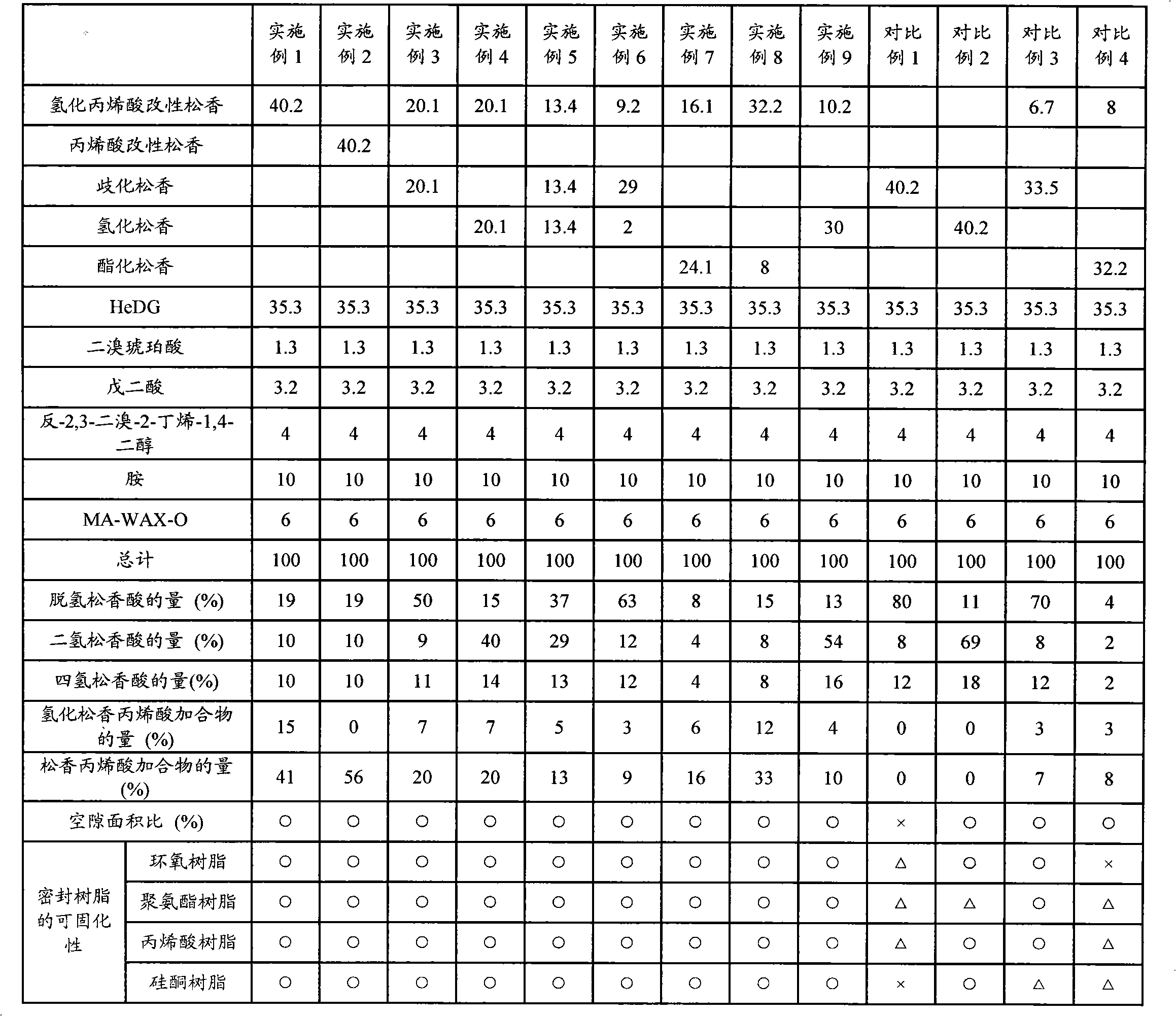Flux composition for lead-free solder, and lead-free solder composition
A lead-free solder and composition technology, applied in the preparation of organic compounds, welding/cutting media/materials, soldering media, etc., can solve problems such as complex fixing processes, and achieve suppression of void generation, prevention of curing inhibition, and excellent wetting sexual effect
- Summary
- Abstract
- Description
- Claims
- Application Information
AI Technical Summary
Problems solved by technology
Method used
Image
Examples
Embodiment 1
[0066]A flux composition for cream solder was prepared by mixing the following components: 40.2% by weight of hydrogenated acrylic acid-modified rosin (manufactured by Arakawa Chemical Industry Co., Ltd.); composition: 19% by weight of dehydroabietic acid, 10% by weight of dihydroabietic acid, 10 wt% tetrahydroabietic acid, 15 wt% hydrogenated rosin acrylic acid adduct and rosin acrylic acid adduct 41 wt%, 1.3 wt% dibromosuccinic acid (manufactured by Aldrich), 3.2 wt% glutaric acid (Tokyo Chemical Co., Ltd.), 4 wt% trans-2,3-dibromo-2-butene-1,4-diol (Tokyo Chemical Co., Ltd.), 10 wt% amine (Lion Akzo Co. , Ltd.), 35.3 wt% of diethylene glycol monohexyl ether (manufactured by Nippon Emulsifier Co., Ltd.), and 6 wt% of thixotropic agent (MA-WAX-O (manufactured by Kawaken Fine Chemical Co., Ltd.)) .
[0067] The flux composition thus obtained was used together with a solder alloy comprising 96.5 wt% Sn, 3.0 wt% Ag and 0.5 wt% copper to prepare a cream solder having a particle ...
Embodiment 2
[0069] Solder cream was obtained in the same manner as in Example 1, except that acrylic acid-modified rosin (manufactured by Arakawa Chemical Industry Co., Ltd.); composition: 19 wt % of dehydroabietic acid, 10 wt % of dihydroabietic acid, 10 wt % % tetrahydroabietic acid and 56wt% rosin acrylic acid adduct) to replace hydrogenated acrylic acid modified rosin (Arakawa Chemical Industry Co., Ltd.); composition: 19wt% dehydroabietic acid, 10wt% dihydroabietic acid, 10wt% % tetrahydroabietic acid, 15 wt% hydrogenated rosin acrylic acid adduct and 41 wt% rosin acrylic acid adduct) were used as rosin derivation components.
Embodiment 3
[0071] Solder cream was obtained in the same manner as in Example 1, except that the same hydrogenated acrylic acid-modified rosin and dehydroabietic acid-rich disproportionated rosin (manufactured by Arakawa Chemical Industry Co., Ltd.; composition: 80 wt% of dehydroabietic acid, 8 wt% of dihydroabietic acid, and 12 wt% of tetrahydroabietic acid; hereinafter referred to as "disproportionated rosin") each replaced 40.2 wt% of hydrogenated acrylic acid-modified rosin in an amount of 20.1 wt%. Arakawa Chemical Industry Co., Ltd.; composition: 19 wt% of dehydroabietic acid, 10 wt% of dihydroabietic acid, 10 wt% of tetrahydroabietic acid, 15 wt% of hydrogenated rosin acrylic acid adduct, and 41 wt% of rosin acrylic acid adduct compounds) are used as rosin-derived components.
PUM
 Login to View More
Login to View More Abstract
Description
Claims
Application Information
 Login to View More
Login to View More - R&D Engineer
- R&D Manager
- IP Professional
- Industry Leading Data Capabilities
- Powerful AI technology
- Patent DNA Extraction
Browse by: Latest US Patents, China's latest patents, Technical Efficacy Thesaurus, Application Domain, Technology Topic, Popular Technical Reports.
© 2024 PatSnap. All rights reserved.Legal|Privacy policy|Modern Slavery Act Transparency Statement|Sitemap|About US| Contact US: help@patsnap.com








